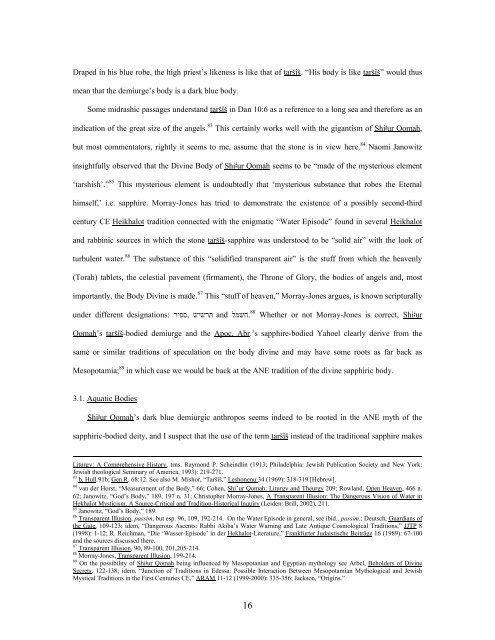Sapphiric God: - Dr. Wesley Muhammad
Sapphiric God: - Dr. Wesley Muhammad
Sapphiric God: - Dr. Wesley Muhammad
You also want an ePaper? Increase the reach of your titles
YUMPU automatically turns print PDFs into web optimized ePapers that Google loves.
<strong>Dr</strong>aped in his blue robe, the high priest’s likeness is like that of taršîš. “His body is like taršîš” would thus<br />
mean that the demiurge’s body is a dark blue body.<br />
Some midrashic passages understand taršîš in Dan 10:6 as a reference to a long sea and therefore as an<br />
indication of the great size of the angels. 83 This certainly works well with the gigantism of Shi#ur Qomah,<br />
but most commentators, rightly it seems to me, assume that the stone is in view here. 84 Naomi Janowitz<br />
insightfully observed that the Divine Body of Shi#ur Qomah seems to be “made of the mysterious element<br />
‘tarshish’.” 85 This mysterious element is undoubtedly that ‘mysterious substance that robes the Eternal<br />
himself,’ i.e. sapphire. Morray-Jones has tried to demonstrate the existence of a possibly second-third<br />
century CE Heikhalot tradition connected with the enigmatic “Water Episode” found in several Heikhalot<br />
and rabbinic sources in which the stone taršîš-sapphire was understood to be “solid air” with the look of<br />
turbulent water. 86 The substance of this “solidified transparent air” is the stuff from which the heavenly<br />
(Torah) tablets, the celestial pavement (firmament), the Throne of Glory, the bodies of angels and, most<br />
importantly, the Body Divine is made. 87 This “stuff of heaven,” Morray-Jones argues, is known scripturally<br />
under different designations: ריפס, שישרת and למשח. 88 Whether or not Morray-Jones is correct, Shi#ur<br />
Qomah’s taršîš-bodied demiurge and the Apoc. Abr.’s sapphire-bodied Yahoel clearly derive from the<br />
same or similar traditions of speculation on the body divine and may have some roots as far back as<br />
Mesopotamia; 89 in which case we would be back at the ANE tradition of the divine sapphiric body.<br />
3.1. Aquatic Bodies<br />
Shi#ur Qomah’s dark blue demiurgic anthropos seems indeed to be rooted in the ANE myth of the<br />
sapphiric-bodied deity, and I suspect that the use of the term taršîš instead of the traditional sapphire makes<br />
Liturgy: A Comprehensive History, trns. Raymond P. Scheindlin (1913; Philadelphia: Jewish Publication Society and New York:<br />
Jewish theological Seminary of America, 1993): 219-271.<br />
83<br />
b. Hull.91b; Gen R. 68:12. See also M. Mishor, “Taršîš,” Leshonenu 34 (1969): 318-319 [Hebrew].<br />
84<br />
van der Horst, “Measurement of the Body,” 66; Cohen, Shi‘ur Qomah: Liturgy and Theurgy 209; Rowland, Open Heaven, 466 n.<br />
62; Janowitz, “<strong>God</strong>’s Body,” 189, 197 n. 31; Christopher Morray-Jones, A Transparent Illusion: The Dangerous Vision of Water in<br />
Hekhalot Mysticism. A Source-Critical and Tradition-Historical Inquiry (Leiden: Brill, 2002), 211.<br />
85<br />
Janowitz, “<strong>God</strong>’s Body,” 189.<br />
86<br />
Transparent Illusion, passim, but esp. 96, 109, 192-214. On the Water Episode in general, see ibid., passim.; Deutsch, Guardians of<br />
the Gate, 109-123; idem, “Dangerous Ascents: Rabbi Akiba’s Water Warning and Late Antique Cosmological Traditions,” JJTP 8<br />
(1998): 1-12; R. Reichman, “Die ‘Wasser-Episode’ in der Hekhalot-Literature,” Frankfurter Judaistische Beiträge 16 (1989): 67-100<br />
and the sources discussed there.<br />
87<br />
Transparent Illusion, 90, 89-100, 201,205-214.<br />
88<br />
Morray-Jones, Transparent Illusion, 199-214.<br />
89<br />
On the possibility of Shi#ur Qomah being influenced by Mesopotanian and Egyptian mythology see Arbel, Beholders of Divine<br />
Secrets, 122-138; idem, “Junction of Traditions in Edessa: Possible Interaction Between Mesopotamian Mythological and Jewish<br />
Mystical Traditions in the First Centuries CE,” ARAM 11-12 (1999-2000): 335-356; Jackson, “Origins.”<br />
16
















